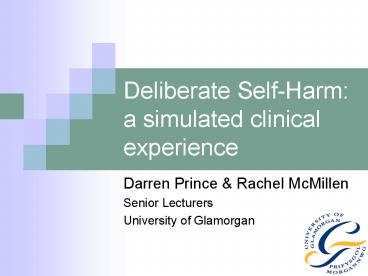Deliberate SelfHarm: a simulated clinical experience PowerPoint PPT Presentation
1 / 20
Title: Deliberate SelfHarm: a simulated clinical experience
1
Deliberate Self-Harm a simulated clinical
experience
- Darren Prince Rachel McMillen
- Senior Lecturers
- University of Glamorgan
2
Outline
- What is deliberate self-harm (DSH)?
- The simulated experience
- Student evaluations
3
DSH the myths
- All self-harm is attention-seeking behaviour
- All self-harm is a sign of mental health
problems - The first thing we must do when helping someone
who self-harms is to get them to stop - People who self-harm dont want to die, they
wont kill themselves
4
DSH the facts
- Admission rate 300 per 100 000 per year
- Average age is 30
- 40 taken a previous overdose
- 20 will take a further overdose within a year,
especially if - History of substance misuse
- Discharge themselves before initial assessment
completed - Several previous episodes
- Up to 10 have mental health problem
5
Self Harm The short-term physical and
psychological management and secondary prevention
of self-harm in primary and secondary care July
2004
Self Harm The short-term physical and
psychological management and secondary prevention
of self-harm in primary and secondary care July
2004 NICE
Truth Hurts Report of the National Inquiry into
Self-Harm among Young People Dr Marcia
Brophy (2006) Camelot Foundation/MHF
Look Beyond The Scars Understanding and
responding to self-harm P Bywaters A
Rolfe (2002) NCH
6
What is Self Harm?
- self-poisoning or injury, irrespective of the
apparent purpose of the act. (NICE, 2004) - Self-injury is a compulsion or impulse to
inflict physical wounds on one's own body,
motivated by a need to cope with unbearable
psychological distress or regain a sense of
emotional balance. The act is usually carried out
without suicidal, sexual, or decorative intent.
(Sutton 2005)
7
Methods
- What is your primary method of self-injury?
(choose one) 38728 votes total - Cutting (27436)
71 - Burning (1750)
5 - Hitting (Self/Object) (1619)
4 - Head banging (455)
1 - Skin picking/Scratching (4721)
12 - Wound Interference (740)
2 - Bone-breaking (196)
1 - Biting (553)
1 - Other (1199)
3 - No Longer SI (59)
0
Self Injury Poll (2004) What is your primary
method of self-injury (online)
httpvote.pollit.com/webpoll2?ID25897 (accessed
25-02-08)
8
DSH Why?
- To stop bad feelings (immediate relief)
- To feel something, even if it was pain
- To punish yourself
- To relieve feeling numb or empty
- To feel relaxed
- Social modeling 82 of responders say at least
one friend self-injured in the last 12 months
Nock and Prinstein (2004) A functional approach
to the assessment of self-mutilative behavior.
Journal of Consulting and Clinical Psychology 72
885-890.
9
Some Quotes (Look Beyond The Scars, 2002)
- Its something that needs to be done to get me
living (Vicky, over 25) - I didnt want to kill myself. I just wanted some
of the hurt and all of the pain to just go away
(Rachel, late teens) - Way of coping when things get really bad.
People deal with things in different ways and,
unfortunately or not, this is my way (Kirsty,
early 20s)
10
How Did It Come About?
- A need for training
- Negative experiences of people who engage in acts
of DSH - Janes Story
- Students feedback from placements
- NMC Simulation Learning Pilot
11
Deliberate Self-Harm
- The Simulated Clinical Experience
12
- TASK
- Meaningfulness
- Typicality
- Relevance
- PHYSICAL CONTEXT
- Work space
- Resources
- Time frame
- CRITERIA
- Based on that used in practice
- Realistic
- Criterion-referenced
- SOCIAL CONTEXT
- Similarity to social context of professional
practice
- RESULT/FORM
- Demonstrate competence
- Presentation to others
- Multiple indicators of learning
Guliker (2004)
13
Evaluations
- Students Evaluations
- Attitudes
- Evaluations Content
- Evaluations Process
14
Attitudes (SHAS, Patterson et al 2007)
Care Appraisal
Care Futility
Rights Responsibilities
Care Intent Manipulation
Acceptance Understanding
15
Content Results
Meeting Needs
Team Player
Care for Person who DSH
Work Therapeutically
Sutures
Knowledge Skills
Lacerations
16
Process Results
Integrate Theory Practice
Valuable Learning Experience
Felt Comfortable
Transfer Learning
Team Playing
17
Service-Users Advice to Professionals
- Treat us with more care, compassion, concern,
support and interest - Listen to us
- Dont judge us
- Respect us as you would others dont treat us
as children/aliens - Look at the individual we have different
reasons for doing it - There is always a reason for self-injury/self-harm
Bywaters P and Rolfe A (2002) Look Beyond the
Scars NCH London
18
- The attitude and behaviour of staff were the
most significant factors affecting service users
experience of care - Palmer L, Blackwell H and Strevens P (2007)
Service User Experience of Emergency Services
following Self-Harm a national survey of 509
patients (online) http//www.rcpsych.ac.uk/resear
chandtrainingunit/centreforqualityimprovement/self
-harmproject.aspx
19
Conclusion
- There is a need for training staff in working
with people who engage in acts of DSH - Simulation of both physical and psychological
care are important - Some evidence that simulation is a useful means
of achieving this
20
Sources
- Gulliker, J.T.M., Bastiaens, T.J., Kirschner,
P.A.(2004) Perceptions of authentic assessment.
Available online at www.ou.nl/Docs/Expertise/OTEC/
Publicaties/judith20gullikers/paper20SIG202004
20Bergen.pdf (Accessed on 6/8/07) - (NICE (2004) Self Harm The short-term physical
and psychological management and secondary
prevention of self-harm in primary and secondary
care. London, NICE. Available online at
www.nice.org.uk (accessed 25/2/08) - Nock and Prinstein (2004) A functional approach
to the assessment of self-mutilative behavior.
Journal of Consulting and Clinical Pyschology.
72, 885-890. - Sutton, J. (2005) Self-harm, deliberate self-harm
and self injury clarifying terms. Available
online at www.siari.co.uk (accessed 6/8/07)

